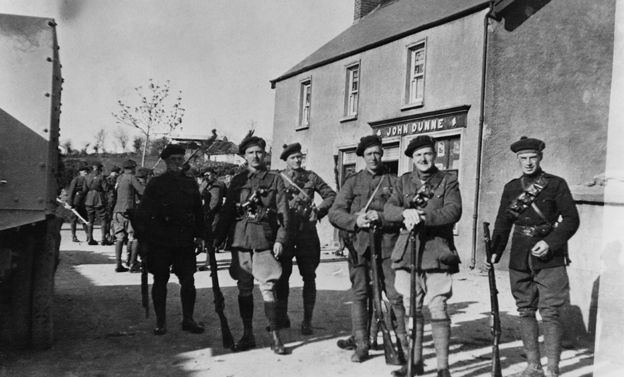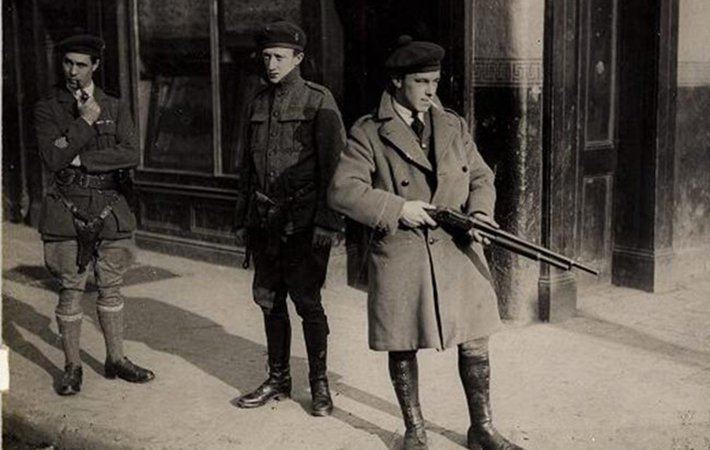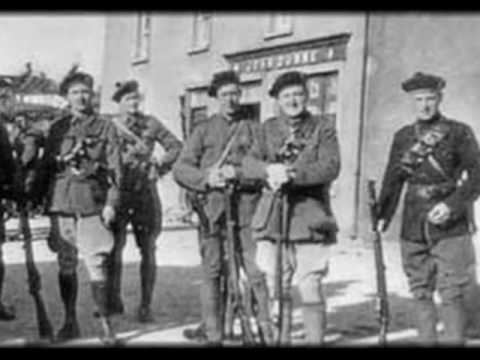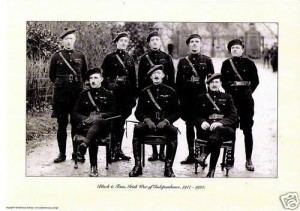Common name Black and Tans Formed 1919 | Abbreviation RICSR Dissolved 1922 | |
 | ||
Legal personality Governmental: Government agency Similar Irish Volunteers, Provisional Irish Republic, Fianna, Official Irish Republican Army, Irish Army | ||
Who were the black and tans actual footage of attacks
The Black and Tans (Irish: Dúchrónaigh), officially the Royal Irish Constabulary Special Reserve, was a force of Temporary Constables recruited to assist the Royal Irish Constabulary (RIC) during the Irish War of Independence. The force was the brainchild of Winston Churchill, then British Secretary of State for War. Recruitment began in Great Britain in late 1919. Thousands, many of them British Army veterans of World War I, answered the British government's call for recruits. Most of the recruits came from Britain, although it also had some members from Ireland. Their role was to help the RIC maintain control and fight the Irish Republican Army (IRA), the army of the Irish Republic. The nickname "Black and Tans" arose from the colours of the improvised uniforms they initially wore, composed of mixed khaki British Army and rifle green RIC uniform parts. The Black and Tans became infamous for their attacks on civilians and civilian property.
Contents
- Who were the black and tans actual footage of attacks
- Foundation
- Conduct
- Government Policy and reaction
- Legacy
- References

The Black and Tans were sometimes confused with the Auxiliary Division, a counter-insurgency unit of the RIC made up of former British officers. However, sometimes the term "Black and Tans" is used to cover both of these groups.

Foundation

The late 19th and early 20th centuries in Ireland were dominated by Irish nationalists' pursuit of Home Rule from the United Kingdom of Great Britain and Ireland. The issue of Home Rule was shelved with the outbreak of World War I, and in 1916 Irish republicans staged the Easter Rising against British rule in an attempt to establish a republic. Growing support amongst the Irish populace for the republican Sinn Féin political party saw it win 73 out of 105 seats in the Irish general election, 1918. On 21 January 1919, Sinn Féin established themselves as the First Dáil, which then declared an independent Irish Republic. They also declared the Irish Republican Army (IRA) the official army of the state, which in the same month began the Irish War of Independence. The main targets of the IRA offensive were the Royal Irish Constabulary (RIC) and the British Army in Ireland.

In September 1919 David Lloyd George, who was British Prime Minister at the time, outlawed the Dáil and augmented the British Army presence in Ireland, starting work on the next Home Rule Act.

In January 1920, the British government started advertising in British cities for men willing to "face a rough and dangerous task", helping to boost the ranks of the RIC in policing an increasingly anti-British Ireland. There was no shortage of recruits, many of them unemployed First World War army veterans, and by November 1921 about 9,500 men had joined. This sudden influx of men led to a shortage of RIC uniforms, and the new recruits were issued with khaki army uniforms (usually only trousers) and dark green RIC or blue British police surplus tunics, caps and belts. These uniforms differentiated them from the British Army and the regular RIC, and gave rise to the force's nickname: Christopher O'Sullivan wrote in the Limerick Echo on 25 March 1920 that, meeting a group of recruits on a train at Limerick Junction, the attire of one reminded him of the Scarteen Hunt, whose "Black and Tans" nickname derived from the colouration of its Kerry Beagles. Ennis comedian Mike Nono elaborated the joke in Limerick's Theatre Royal, and the nickname soon took hold, persisting even after the men received full RIC uniforms. The popular Irish claim made at the time that most of men serving the Black and Tans had criminal records and had been recruited straight from British prisons is incorrect, as a criminal record would disqualify one from working as a policeman. The vast majority of the men serving in the Black and Tans were unemployed veterans of the First World War who were having trouble finding jobs, and for most of them it was economic reasons that drove them to join the Temporary Constables.

The new recruits received three months' hurried training, and were rapidly posted to RIC barracks, mostly in rural County Dublin, Munster and eastern Connacht. The first men arrived on 25 March 1920. The British government also raised another unit, the Auxiliary Division of the constabulary, known as the Auxiliaries or Auxies, consisting of ex-army officers. The Black and Tans aided the Auxiliaries in the British government's attempts to break both the IRA and the Dáil. The Blacks and Tans were meant to back up the RIC in the struggle against the IRA, playing a defensive-reactive role whereas the role of the "Auxies" were those of heavily armed, mobile units meant for offensive operations in the Irish countryside intended to hunt down and destroy IRA units. At least part of the infamy of the Blacks and Tans is undeserved as many of the war crimes attributed to the Blacks and Tans were actually the work of the "Auxies".
Conduct
Temporary Constables were paid the relatively good wage of 10 shillings (half a pound) a day, plus full board and lodging. With minimal police training, their main role was to increase the strength of police posts, where they functioned as sentries, guards, escorts for government agents, reinforcement to the regular police, and crowd control. They mounted a determined counter-insurgency campaign. They and the Auxies became known as Tudor's Toughs after the police commander, Major-General Sir Henry Hugh Tudor. They were viewed by republicans as akin to an army of occupation because of these duties. They soon gained a reputation for brutality, as the RIC campaign against the IRA and Sinn Féin members was stepped up and police reprisals for IRA attacks were condoned by the government.
Alexander Will, from Forfar in Scotland, was the first Temporary Constable to die in the conflict. He was killed during an IRA attack on the RIC barracks in Rathmore, County Kerry, on 11 July 1920.
The Black and Tans were not subject to strict discipline in their first months and, as a result, their deaths at the hands of the IRA in 1920 were often repaid with arbitrary reprisals against the civilian population. In the summer of 1920, the Black and Tans burned and sacked many small towns and villages in Ireland, beginning with Tuam in County Galway in July 1920 and also including Trim, Balbriggan, Knockcroghery, Thurles and Templemore amongst many others. In November 1920, the Tans "besieged" Tralee in revenge for the IRA abduction and killing of two local RIC men. They closed all the businesses in the town, let no food in for a week and shot dead three local civilians. On 14 November, the Tans were suspected of abducting and murdering a Roman Catholic priest, Father Michael Griffin, in Galway. His body was found in a bog in Barna a week later. From October 1920 to July 1921, the Galway region was "remarkable in many ways", most notably the level of police brutality towards suspected IRA members, which was far above the norm in the rest of Ireland. On the night of 11 December 1920, they sacked Cork, destroying a large part of the city centre.
In January 1921, the British Labour Commission produced a report on the situation in Ireland which was highly critical of the government's security policy. It said the government, in forming the Black and Tans, had "liberated forces which it is not at present able to dominate". However, since 29 December 1920, the British government had sanctioned "official reprisals" in Ireland – usually meaning burning property of IRA men and their suspected sympathisers. Taken together with an increased emphasis on discipline in the RIC, this helped to curb the random atrocities the Black and Tans committed since March 1920 for the remainder of the war, if only because reprisals were now directed from above rather than being the result of a spontaneous desire for revenge.
Many of the activities popularly attributed to the Black and Tans may have been committed by the Auxiliary Division; and some were committed by regular RIC men. For instance, Tomás Mac Curtain, the Mayor of Cork, was assassinated in March 1920 by local RIC men and the shooting dead of 13 civilians at Croke Park on Bloody Sunday was also carried out by the regular RIC, although a small detachment of Auxiliaries were also present. Most Republicans did not make a distinction, and "Black and Tans" was often used as a catch-all term for all police groups.
Government Policy and reaction
The actions of the Black and Tans alienated public opinion in both Ireland and Great Britain. Their violent tactics encouraged the Irish public to increase their covert support of the IRA, while the British public pressed for a move towards a peaceful resolution. Edward Wood MP, better known as the future Foreign Secretary Lord Halifax, rejected force and urged the British government to make an offer to the Irish "conceived on the most generous lines". Sir John Simon MP, another future Foreign Secretary, was also horrified at the tactics being used. Lionel Curtis, writing in the imperialist journal The Round Table, wrote: "If the British Commonwealth can only be preserved by such means, it would become a negation of the principle for which it has stood". The King, senior Anglican bishops, MPs from the Liberal and Labour parties, Oswald Mosley, Jan Smuts, the Trades Union Congress and parts of the press were increasingly critical of the actions of the Black and Tans. Mahatma Gandhi said of the British peace offer: "It is not fear of losing more lives that has compelled a reluctant offer from England but it is the shame of any further imposition of agony upon a people that loves liberty above everything else".
About 7,000 Black and Tans served in Ireland in 1920–22. More than one-third left the service before they were disbanded along with the rest of the RIC in 1922, an extremely high wastage rate, and well over half received government pensions. A total of 404 members of the Royal Irish Constabulary died in the conflict and more than 600 were wounded but it is not clear how many of these were regular RIC men and how many were Black and Tans or Auxiliaries.
Those who returned to civilian life sometimes had problems re-integrating. At least two former Black and Tans were hanged for murder in Britain and another wanted for murder committed suicide before the police could arrest him.
Legacy
Due to the ferocity of the Tans' behaviour in Ireland and the numerous war crimes they committed, feelings continue to run high regarding their actions. "Black and Tan" or "Tan" remains a pejorative term for the British in Ireland, and the reputation of the Tans is still hated in Ireland. The term can still stir bad reactions because of their remembered brutality. One of the best known Irish Republican songs is Dominic Behan's "Come out Ye Black and Tans". The Irish War of Independence is sometimes referred to as the "Tan War" or "Black-and-Tan War." This term was preferred by those who fought on the anti-Treaty side in the Irish Civil War and is still used by Republicans today. The "Cogadh na Saoirse" medal, awarded since 1941 by the Irish government to IRA veterans of the War of Independence, bears a ribbon with two vertical stripes in black and tan.
